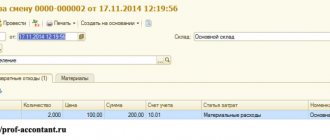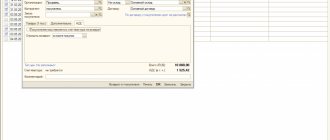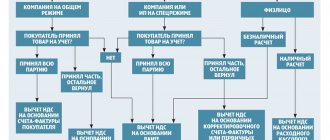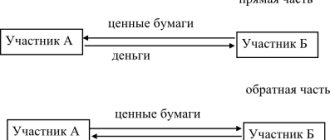Types of bonuses that affect how they are reflected in accounting
The concept of “bonus” implies a fairly wide range of applications of this definition, despite the fact that in each specific case it will correspond in meaning to the same meaning: remuneration.
Remuneration, called a bonus, can be awarded as:
- monetary or other material rewards for any achievements received by specific people or organizations;
- difference in price set for the same product;
- the amount paid by the buyer to the seller for the right, during a specified period of time, to buy from him a specific asset (securities) at an agreed price;
- funds paid by the policyholder to the insurer upon concluding an insurance contract.
Each of these groups has its own characteristics of reflection in accounting (BU) and tax (TA) accounting.
ConsultantPlus experts explained in detail how to prepare documents for a bonus for an employee. To do everything correctly, get trial access to the system and go to the Ready solution.
Features of taxation when taking into account bonuses
Accounting and calculation of VAT amount
A purchasing enterprise that has received a bonus (in the form of a discount, premium) for fulfilling the volume of purchase of goods specified in the contract must not:
- Restore the amount of VAT that has been accepted for deduction. The provisions of the Tax Code require this to be done only when a separate clause in the contract stipulates a decrease in the commodity value. When food products are purchased, VAT is not reinstated in any case.
- Separate VAT from the bonus amount even when it is a cash bonus. Material incentives to the buyer for conscientious fulfillment of the previously established terms of the agreement are included in the contract price. This amount is not taken into account when determining the cost of goods. Therefore, the bonus does not affect their price, and there are no grounds for restoring the deductible VAT.
Income tax accounting
Bonus raw materials, products, goods are recognized as property received free of charge. Their cost should be taken into account in the income on which income tax is calculated. The bonus amount should be included in non-operating income:
| Conditions | On the date |
| The agreement stipulates the provision of a bonus. This is recorded in a separate paragraph | receiving a bonus from the supplier |
| There was no bonus provided when concluding the contract | drawing up and signing an additional agreement. It states that the bonus will be provided |
Employee bonuses: included in income tax expenses or attributed to net profit
The most common type of bonus is that paid to employees. They share:
- on those included in the wage system;
- not included in this system.
Inclusion in the remuneration system (i.e., in wages) implies:
- Reflection of this circumstance in the internal regulatory act.
- Direct connection between bonuses and employee performance.
- Development of a bonus system as a description of all bonuses paid by the employer, the principles of the emergence of the right to accrue them, calculation algorithms, and circumstances serving as the basis for deprivation of a bonus. This system can be quite complex, including both regularly accrued remuneration and bonuses from the fund of the head of the organization or its division, paid periodically.
Remunerations that are not included in the salary may be reflected in the bonus system, but they will be distinguished from bonuses regarded as payment for work by the lack of connection with labor achievements and the irregularity of payment.
Read about existing types of employee incentives in the article “What are the types of bonuses and employee benefits?”
The accrual of bonuses that form the employee’s salary is done in accounting by posting:
Dt 20 (23, 25, 26, 29, 44) Kt 70.
Bonuses, which are a salary, are fully included in the expenses taken into account in the NU when determining the profit base.
Remunerations that are not included in the salary are not reduced to the profit base (letter of the Ministry of Finance of Russia dated April 24, 2013 No. 03-03-06/1/14283), but are included in net profit.
Are insurance premiums paid to employees from net profit? You will find the answer to this question in ConsultantPlus. Trial access to the legal system is free.
Postings for bonuses at the expense of net profit in accounting can have two options:
- with attribution to costs, but as expenses not taken into account for NU:
Dt 20 (23, 25, 26, 29, 44) Kt 70;
- with write-off from existing profits of previous years:
Dt 84 Kt 70;
- with inclusion in other expenses of the current year (in the absence of profits from previous years), not taken into account for NU purposes:
Dt 91 Kt 70.
Features of tax accounting in trade: discounts, premiums, bonuses
The main document regulating accounting at an enterprise is the Federal Law “On Accounting”. Features of accounting are also regulated by the Accounting Regulations (PBU). Despite this, each field of activity also has its own specific accounting features. Economic mechanisms in areas such as manufacturing, construction and trade are very different. We will talk about the last area, namely trade, in more detail in this article. What is meant by trade? This is a type of business activity that is associated with the purchase and sale of goods and the provision of various services to the population. Trade is a very common type of activity, especially in small and medium-sized businesses. The reason for this is very simple: trading ensures a quick turnover of funds. Incentive payments for buyers are a common practice to attract customers in trading activities. There are several names for such payments: discounts, bonuses, bonuses, gifts. The main points that influence the reflection of these payments in accounting and tax accounting are: - whether the price decreases as a result of the provision of this discount; — at what point did the price decrease occur? Both points should be directly reflected in contracts with buyers.
Is it necessary to charge tax on bonuses from a public organization?
A bonus paid by a public organization for any achievements can be intended for both a legal entity and an individual. The tax on the bonus in both cases must be withheld by the organization that paid the bonus, taking into account that an individual will have a non-taxable amount not exceeding 4,000 rubles.
The income received by an individual in such a situation will not be reflected in any way by his employer. But if a legal entity received the bonus, then it will take it into account in its accounting system as other income:
Dt 76 Kt 91.
If, when paying bonuses, income tax is withheld by the organization that paid the bonus, then the recipient of the bonus will not take this income into account for tax purposes. But if there was no tax withholding, then you will have to calculate it yourself.
Studying the contract
When a seller provides a premium to a wholesale buyer (trading organization), it usually:
- is associated with the fulfillment of a number of conditions. For example, the buyer must buy a certain amount of goods from the seller;
- is transferred to the buyer's account.
This is exactly the situation we will consider.
If the contract provides for a reduction in the cost of previously shipped goods by the amount of the premium (or other incentive payment), then both the seller and the buyer must take it into account in the same way as a retro discount. And vice versa: even if the contract states that the buyer is provided with a retro discount, which does not reduce the price of the goods, then it must be reflected as a premium that does not affect the price of the goods.
The rules for issuing a premium depend on what is specified in the contract for the supply of goods:
- <if>it directly stipulates the conditions under which the seller is obliged to pay the buyer a premium in a certain amount, then both the seller and the buyer can charge such a premium automatically;
- <if>it says that the premium is provided to the buyer on the basis of a separate document (notice, notice from the seller), then such a document will need to be drawn up. For example, an agreement to provide a bonus might look like this.
In connection with the achievement in the second quarter of 2021 by the Buyer of Sinitsa LLC of the volume of purchased goods in an amount exceeding 300,000 rubles. (excluding VAT), the Seller LLC “Zhuravl” provides the Buyer with a premium of 4% of the cost of purchased goods (excluding VAT).
The total cost of purchased goods in the second half of the year (excluding VAT) is 460,000 rubles.
The bonus amount is 18,400 rubles. (RUB 460,000 x 4%), it does not affect the cost of shipped goods.
The premium must be transferred to the Buyer's bank account within 10 calendar days.
Also, the condition for payment of the premium can be provided in an additional agreement to the contract.
The influence of discounts (bonuses) for customers on data generated in management accounting
In the relationship between sellers and buyers, a fairly widespread system of providing discounts on the price of goods through the issuance of bonuses, which does not imply a change in the cost of what is sold, but the payment of a bonus for achieving a certain volume of purchases. Such a premium allows you not to revise the sales price and, accordingly, does not in any way affect the amount of VAT. But for both parties to the transaction it is taken into account in the NU for profit, which makes it possible to regulate the amount of taxable income to the values provided for in management accounting.
The accrual of such a premium in accounting is done by the following transactions:
- Dt 91 Kt 76 - from the party providing the bonus (discount);
- Dt 76 Kt 91 - the recipient of this bonus.
In this situation, as a rule, money transfers are not made, but offset is carried out, the result of which is a reduction in the buyer’s debt for the goods transferred to him.
For information about what factors should be kept in mind when calculating this bonus, read the material “The Ministry of Finance recalled the conditions for taking into account the buyer’s premium for the volume of purchases in expenses.”
See also: "[INCOME TAX]: Conditions to take into account the buyer's bonus."
Accounting for buyer bonuses
The receipt of bonus assets leads to an increase in economic benefits, which is recognized as income, and the buyer must take into account the cost of such goods in accounting as part of other income.
Bonus goods are accepted for accounting at actual cost. But PBU 5/01 “Accounting for Inventory” does not contain any special procedure for determining it for inventory items received under paid contracts and not paid for. Therefore, purchasing companies have the right to accept goods for accounting at the current market or regular price for its purchase from the supplier. The buyer can take it into account using an account. 98 “Deferred income” (as applied in case of gratuitous transfer) or without his participation, which in practice happens more often.
Let's continue the example - accounting for bonuses from the buyer:
The buyer will reflect the transaction for accounting for the bonus reward in accounting as follows:
| Operations | D/t | K/t | Amount in rub. |
Free receipt of bonuses - goods (10,000 x  | 80 000 | ||
| Other income includes the cost of the bonus | 80 000 | ||
| Bonus income reflects a permanent tax liability, since, unlike accounting, in tax accounting its value will be zero (80,000 x 20%) | 16 000 |
For the buyer, a product bonus (compared to a cash bonus) is also less profitable, since it should be taken into account in non-operating income (clause 8 of Article 250 of the Tax Code of the Russian Federation) on the date of receipt, capitalized at market value and income tax paid on this value. When selling bonus goods, the buyer will not be able to reduce the profit tax base by their cost, since he did not bear the costs of purchasing them.
Option premium: accounting and tax accounting
Option premium is an accessory to option contracts, the essence of which is to assign for a certain period to the buyer the right to purchase at the cost of a specific asset (securities) specified in the contract. For this right, the buyer pays the seller a certain amount called an option premium. You can refuse to exercise an option contract. The premium is non-refundable.
A feature of accounting for actions under option contracts is that the future subject of the transaction itself is taken into account off the balance sheet until the moment of its actual purchase and sale:
- on account 008 - from the buyer;
- on account 009 - with the seller.
The future seller includes the received option premium in income both in the accounting book and in the accounting book, reflecting this in the accounting book by posting:
Dt 76 Kt 91.
The buyer may have options for accounting for premiums in accounting, the choice of which should be fixed in the accounting policy. They allow you to take into account the paid premium as:
- expenses for upcoming periods:
Dt 97 Kt 76;
- other expenses:
Dt 91 Kt 76.
The amount of the bonus may be excluded from the expenses of the coming periods:
- in installments during the validity period of the right to purchase, charged to other expenses:
Dt 91 Kt 97;
- at a time with its inclusion in the cost of the acquired asset:
Dt 58 Kt 97.
The amount of the premium attributed to other expenses at the time of the actual acquisition of the asset must be restored and included in the cost of the asset as costs associated with its purchase (clause 9 of PBU 19/02, approved by order of the Ministry of Finance of Russia dated December 10, 2002 No. 126n):
Dt 58 Kt 91.
For NU purposes, the option premium is recognized as an expense on the date of its payment, regardless of whether the purchase is subsequently made (Article 326 of the Tax Code of the Russian Federation).
Thus, an asset acquired through an option contract will have a different value in accounting and in NU.
Accounting accounts and entries for discounts, gifts and bonuses
Important! In accounting, raw materials are written off and their cost is not recorded in income. Accounting for discounts on goods (services) Discounts mean a slight reduction in the price fixed in the contract for the goods (products) supplied or services provided. They become reality only when certain conditions are met.
Types of discounts: Discounts Characteristics Real The actual cost of sold products (goods) has already been reduced. Available at the time of delivery. Future deliveries of goods in the near future. Provided for future sale and only when the pre-agreed points of the contract are fulfilled. Retro discounts are valid after the sale of the goods.
It is planned to reduce the buyer's accounts payable. This creates income that is subject to taxation. When fulfilling the terms of the supply contract, the buyer in the future has the opportunity to spend, for example, mythical points or receive as a gift any product, either related to the previous delivery or not having anything to do with it. The bonus product must be capitalized at the market price, which is why we recommend having supporting documents to determine the market price for a non-identical product provided to you by the supplier. Otherwise, the tax office itself will evaluate the bonus product. We will consider the bonus as an additional product. Discount. In the practice of contractual relations, there are different discounts: “present”, “future” and retro discounts. “Real” discounts have already reduced the actual cost of goods. "Future" discounts are directly related to the next supply of goods. They are provided only if certain conditions of the contract are met.
There are several options here: Options Providing a bonus Amount Option 1 The supplier provided a bonus in cash The amount of the bonus is taken into account in income on the date of its receipt Option 2 The bonus reduces accounts payable The cost of the goods (in tax accounting) is determined minus the bonus amount Option 3 The incentive is counted as payment for the next delivery of products The amount is reflected in income when the specified batch of products arrives. Goods delivered in front of her are considered paid for in full. For tax purposes, they are taken into account at a price that does not contain a bonus. Accounting for bonuses under the UTII regime. When an enterprise conducts exclusively activities that are subject to UTII, it is not expected to pay any other taxes on the bonus amount.
This fully applies to incentives in the form of a cash bonus.
Numerous corrections must be made in accounting on both sides. The following example shows transactions that are relevant when the goods have not yet been sold at the time the discount is granted. Example No. 1. The Computers for Everyone enterprise purchased 20 printers. One of the clauses in the contract with the seller provides for a 2% discount.
- The total cost of the printers is 141,600 rubles.
(excluding discount). - Taking into account the 2% discount: 141,600 · 0.98 = 138,768 rubles.
- VAT = 138,768 · 0.18: 1.18 = 21,168 rub.
- Without VAT: 138,768 – 21,168 = 117,600 rubles.
The following entries must be made in the accounting documents: Accounts Description Amount, rub. This is either the day of receipt of primary documents that confirm that the seller has reduced the cost of purchased goods by the amount of the incentive. Or the date of receipt of the adjustment invoice issued by the seller for the premium. This conclusion was made by representatives of the Russian Ministry of Finance in letters dated September 3, 2012 No. 03-07-15/120 and dated May 31, 2012 No. 03-07-11/163. And if the premium from the supplier affected the amount of VAT for the current period, then you will adjust the amount of tax on the current date (clause 2 of Article 171, clause 1 of Article 172 of the Tax Code of the Russian Federation). It happens that prices change for goods that the supplier shipped according to several invoices. In this case, the seller can draw up only one adjustment document addressed to the buyer (paragraph 2, subparagraph 13, paragraph 5.2 of Article 169 of the Tax Code of the Russian Federation). When combining UTII with the “simplified” tax, the income that is taken into account in calculating the tax is part of the bonus. It is determined by the type of activity that does not apply to UTII. In accounting, this is reflected as follows: Accounts Description Debit Credit 60 91 Reflects the amount of incentive received 60 60 Bonus is counted towards payment for future product deliveries 51 60 Incentive received Retrobonuses received from a supplier entail clarification of the amount of income and expenses (in tax accounting ). In the Tax Code, such a procedure is not regulated clearly enough. Therefore, in order to avoid additional problems and claims, it is advisable to omit the clause in the contract that provides for adjustment of the price of goods purchased earlier. Questions that are asked most often Question No. 1. The supplier decided to reward the buyer, a legal entity, with a gift in an amount exceeding 3,000 rubles.
Features of insurance premium accounting
An insurance premium is a fee for concluding an insurance contract. For the insurer, it is income from the main activity and is taken into account at the time the insurance contract comes into force both in the accounting system and in the NU:
Dt 62 Kt 90.
The policyholder may expense this premium in different ways depending on the relevant accounting policies:
- at a time in the full amount, which is allowed by paragraphs. 16–18 PBU 10/99, approved by order of the Ministry of Finance of Russia dated May 6, 1999 No. 33n:
Dt 20 (23, 25, 26, 29, 44) Kt 76;
- in parts during the validity period of the insurance contract.
In the second option, writing off premium expenses is possible in two ways:
- in correspondence with the account for accounting settlements with the insurer:
Dt 20 (23, 25, 26, 29, 44) Kt 76;
- through the expense account for future periods:
Dt 97 Kt 76,
and then:
Dt 20 (23, 25, 26, 29, 44) Kt 97.
In NU, a lump sum insurance premium can be taken into account in expenses only under an agreement whose validity period falls entirely within the reporting period established for income tax. A contract that does not meet this condition will require a proportional distribution of premium costs (clause 6 of Article 272 of the Tax Code of the Russian Federation). In addition, there are a number of restrictions on amounts due to which the premium may not reduce the tax base in full.
Thus, in terms of insurance premiums, differences may also arise between BU and NU.
Read more about the occurrence of these differences in the article “Entering insurance premiums in accounting”.
Accounting for bonuses, bonuses and gifts from the supplier
We will look at the features of accounting for premiums, bonuses and discounts from the buyer. Let's touch on both tax and accounting.
The relationship between supplier and buyer can be very diverse. For example, in order to increase sales, a supplier provides discounts to regular customers, cash bonuses may be provided to VIP customers, and bonus goods are shipped to some customers. Each of these elements of trade brings positive aspects for the buyer, namely, saving money and increasing assets. But, like any coin, there is a second side - taxation of income received. Let's take a closer look at each element of incentive trading - premium, bonus, buyer discount.
Distinctive features of incentives: Bonus. At the moment, the legislation does not have clear terms for different types of incentives. The bonus, in its economic meaning, involves the receipt of income. In this case, along with the goods, the buyer receives income from the supplier, expressed in cash or in kind. A bonus is usually provided for fulfilling the terms of the contract in excess of the purchase volume or cost, or the amount of payment (for example, 100 percent prepayment), etc. The parties to the contract independently and at their own discretion set the amount of the premium, but the law provides for exceptions. Regarding food products, the premium cannot exceed 10 percent of the price of purchased food products (Part 4, Article 9 of Federal Law No. 381-FZ of December 28, 2009). Bonus. There is no official interpretation of this term in the legislation. In economic terms, a bonus is very similar to a bonus in kind with a distinctive feature - it can be provided for the future. When fulfilling the terms of the supply contract, the buyer in the future has the opportunity to spend, for example, mythical points or receive as a gift any product, either related to the previous delivery or not having anything to do with it. The bonus product must be capitalized at the market price, which is why we recommend having supporting documents to determine the market price for a non-identical product provided to you by the supplier. Otherwise, the tax office itself will evaluate the bonus product. We will consider the bonus as an additional product. Discount. In the practice of contractual relations, there are different discounts: “present”, “future” and retro discounts. “Real” discounts have already reduced the actual cost of goods. "Future" discounts are directly related to the next supply of goods. They are provided only if certain conditions of the contract are met. Retro discounts are the most difficult component of incentive trading, as they entail numerous corrections in the accounting of both parties. When receiving a retro discount, the buyer's accounts payable are reduced and taxable income arises. Next, we will consider receiving a discount on a product, which entails a price change.
Features of accounting and tax accounting for received bonuses Let's consider the buyer's accounting when receiving a cash bonus from a supplier. The company conducts settlements with the supplier using account 60 and after posting the goods in accounting, the following entries must be made: Debit 60 Credit 90.1 - a bonus was accrued from the supplier upon fulfillment of the terms of the contract (supply agreement, accounting certificate); Debit 51 Credit 60 - bonus received to the current account (bank statement on the current account).
In accounting, the buyer will show the premium as part of other income. Accounting entries will be made only after receiving a notice or other document from the supplier about the provision of the premium. For purchased goods, the buyer accepts VAT deduction based on the invoice. From July 1, 2013, the buyer does not reduce VAT previously accepted for deduction, with the exception of cases when the premium reduces the cost of shipped goods (clause 2.1 of article 154 of the Tax Code of the Russian Federation, clause 1 of article 1, part 2 of article 5 of the Federal Law dated 04/05/2013 No. 39-FZ). The most important thing is that when a condition in the contract is fulfilled regarding the excess of the purchase volume or the cost of goods, the premium received is not taken into account as a separate component and VAT is not charged separately (letter of the Ministry of Finance of Russia dated December 14, 2010 No. 03-07-07/78, resolution of the Presidium Supreme Arbitration Court of the Russian Federation dated 02/07/2012 No. 11637/11 in case No. A40-56521/10-35-297). The premium received from the supplier is included in the tax base for income tax. It must be taken into account as part of non-operating income (letters dated December 28, 2012 No. 03-01-18/10-200 (clause 3), dated December 19, 2012 No. 03-03-06/1/668, dated September 27, 2012 No. 03 -03-06/1/506). The date of receipt of non-operating income in the form of gratuitously received property is the date the parties signed the act of acceptance and transfer of property, regardless of the method of recognition of income and expenses used in tax accounting (clause 1, clause 4, article 271, clause 2, article 273 of the Tax Code of the Russian Federation).
How to take into account the bonus received from the supplier? Consider the case of a manufacturing enterprise that has paid for the supply of raw materials and, as a bonus, receives several more units of the same raw materials. The following entries must be made in accounting: Debit 60 Credit 91.1 - reflect the bonus from the supplier as other income (supply agreement, accounting certificate); Debit 10.1 Credit 60 – we capitalize bonus raw materials from the supplier (shipping documents of the supplier, receipt order); Debit 20 Credit 10.1 - bonus raw materials are written off for production (invoice requirement); Debit 99 Credit 68 - reflect the permanent tax liability (accounting certificate-calculation).
In accounting, the company capitalizes bonus raw materials as part of inventories and reflects them on account 10. According to the Civil Code of the Russian Federation, bonus goods from the supplier are not considered transferred free of charge, since in order to receive it the buyer has fulfilled certain conditions (clause 1 of Article 423 of the Civil Code of the Russian Federation). The company's accounting must reflect the constant difference between accounting and tax accounting. When bonus raw materials are written off for production, the cost is formed in accounting, but in tax accounting this does not in any way affect the tax base. Regarding VAT, the buyer does not have the right to deduct, since VAT on such goods is not presented by the supplier (Clause 1, Article 172 of the Tax Code of the Russian Federation, paragraph “a”, Clause 19 of the Rules for maintaining a purchase book used in calculations of value added tax , approved by Decree of the Government of the Russian Federation dated December 26, 2011 No. 1137, letter of the Ministry of Finance of Russia dated March 21, 2006 No. 03-04-11/60). As for income tax, bonus raw materials must be regarded as property received free of charge, which is included in taxable income (clause 2 of Article 248 of the Tax Code of the Russian Federation). As noted above, when materials received free of charge are written off for production, their cost is not taken into account in expenses (clause 2 of Article 254 of the Tax Code of the Russian Federation, letter of the Ministry of Finance of Russia dated September 26, 2011 No. 03-03-06/1/590).
Accounting and taxation of discounts Let's consider a situation where the seller provides a discount to the buyer subject to the condition of the agreement on early payment for the goods. When purchasing, we are talking about one price; it is at this price that the primary documents and invoice are drawn up. The buyer paid the entire amount ahead of schedule at once and the supplier issues an adjustment invoice on the day of payment and makes corrections in the primary documents. We make the following entries in accounting: On the date of purchase of goods Debit 41 Credit 60 - goods from the supplier were capitalized (shipping documents from the supplier, goods acceptance certificate); Debit 19 Credit 60 - incoming VAT (invoice) is taken into account; Debit 68 Credit 19 - input VAT (invoice) has been accepted for deduction.
On the date of receipt of the right to a discount Debit 60 Credit 51 - payment is transferred taking into account the due discount (accounting statement, bank statement on the current account); Reversal Debit 41 Credit 60 - actual costs for the purchase of goods for which a discount was received were adjusted (contract, notification of the right to a discount, accounting statement); Reversal Debit 19 Credit 60 - the submitted VAT has been adjusted in the part attributable to the contractual value of the goods for which a discount was received (agreement, notification of the emergence of the right to a discount, accounting statement-calculation); Debit 41 Credit 60 - goods were accepted for accounting at a price taking into account the discount received (agreement, notification of the emergence of the right to a discount, accounting statement); Debit 19 Credit 60 - reflects the amount of VAT presented by the supplier on the cost of purchased goods taking into account the discount (adjustment invoice); Debit 19 Credit 68 - VAT has been restored from the amount of the discount provided, accepted for deduction (adjustment invoice).
The contract is executed at the price specified in the contract. The price of the contract can be changed after the conclusion of the contract (clauses 1, 2 of Article 424 of the Civil Code of the Russian Federation). Before the terms of the contract are fulfilled, the buyer receives the goods at full cost. Only after receiving notification of the right to a discount can the buyer make adjustments to the value of the goods received. The purchasing company has the right to deduct VAT. At the very beginning of the operation, she declares it to be deducted in full. Then, after receiving a notification about the discount, the company realizes that it has excessively deducted VAT. The difference between the product amounts before and after the discount is subject to restoration. For income tax - when purchasing goods, the company incurs direct expenses, which are fully taken into account in the tax base. Direct expenses are recognized after the goods are sold. The discount was received before the purchased goods were sold, therefore, the purchase price changes in accounting. And regardless of the cost accounting method, expenses will take into account the already adjusted purchase price of goods.
Results
The use of the term “premium” is quite diverse. It is most often used as a synonym for remuneration paid for certain achievements. But it may also correspond to the concept of a board:
- for fulfilling the conditions for the volume of purchases;
- for the right to make a future purchase on agreed terms;
- for concluding a contract.
Each of the existing types of bonuses has its own characteristics of reflection in accounting and accounting records.
You can find more complete information on the topic in ConsultantPlus. Free trial access to the system for 2 days.
Discounts
There is no such concept in the legislation, but in practice, a discount is understood as a reduction in the price of a product. All conditions for discounts are reflected in the agreement between the seller and the buyer. Conditions required to provide a discount: - procedure for provision; - amount or percentage.
Accounting for discounts
If the discount was provided at the time of shipment of the goods, then for accounting purposes this operation is a sale for the usual type of activity, the discount is not taken into account, the amount of the operation is reduced by the amount of the discount. Postings: - Debit 62 (50) Credit 90-1 – revenue from sales is reflected (including discount); — Debit 90-3 Credit 68 subaccount “Calculations for VAT” - VAT is charged on the sales amount. If a discount is provided on an item that has already been sold, then it is important to understand whether it was provided before the end of the year or after. If a discount is provided in the current period, you must adjust sales revenue at the time the discount is granted. Thus, reflection in accounting at the time of sale: - Debit 62 (50) Credit 90-1 - revenue from sales is reflected; — Debit 90-3 Credit 68 subaccount “Calculations for VAT” - VAT is charged on the sales amount. Reflection in accounting at the time of granting a discount on the basis of an adjustment invoice: - Debit 62 Credit 90-1 - revenue on previously shipped goods was reversed (in the amount of the discount provided); — Debit 90-3 Credit 68 subaccount “Calculations for VAT” – VAT is reversed from the amount provided. If a discount was provided for previous periods, then the amount of such a discount must be reflected as part of other expenses in the current period on the date the discount was granted (PBU 10/99). Posting: - Debit 91-2 Credit 62 – losses of previous years associated with the provision of a discount to the buyer are reflected; — Debit 68 subaccount “Calculations for VAT” Credit 62 – accepted for deduction of VAT from the amount of the discount provided.
VAT accounting for discounts
Accounting for VAT on discounts depends on the time at which the discount was provided. - at the time of shipment of goods. In this case, the seller reflects the price of the goods in the shipping documents (invoice, TORG-12, UPD and others) taking into account the discount. Accordingly, the seller also charges the buyer VAT, which is calculated on the reduced cost of the goods. The buyer accepts this amount as a deduction. The seller will determine his VAT base as the cost of goods sold, taking into account the reduced price. This type of discount usually does not create difficulties for accountants when preparing accounting and tax reporting. — after shipment of the goods (retro discount). Since there is a change in the price of the product, the seller must issue an adjusted invoice. This invoice must be recorded in the purchase ledger. Based on the adjustment invoice, the seller will be able to deduct the amount of VAT by which the cost of shipped goods has decreased. There is no need to adjust the period in which the shipment took place and an updated declaration is not provided. IMPORTANT!!! If the buyer has already paid for the goods and the seller is not going to return the difference, then this amount will qualify as an advance. And the seller must calculate and pay VAT on the advance payment. The buyer, upon receiving an adjustment invoice, is obliged to restore for payment to the budget the amount of VAT that was accepted for deduction at the original cost. The tax amount must be restored to the extent by which the amount of goods shipped was reduced. The buyer must register such an invoice in the sales book.
Income tax when applying a discount.
When setting the price of a product, after the product has been shipped, there is a reduction in previously recognized expenses from sales of goods from the seller. Therefore, he can adjust the income tax amounts. The seller of goods has the right to submit an updated declaration with sales proceeds that were reduced in the specific reporting period in which the shipment was made.
simplified tax system
Organizations that pay a single tax on income do not take into account expenses, including incentives provided to customers, when calculating the single tax (clause 1 of Article 346.18 of the Tax Code of the Russian Federation).
For organizations that have chosen such an object of taxation as income reduced by the amount of expenses, the list of expenses taken into account when calculating the tax base is limited by Article 346.16 of the Tax Code of the Russian Federation. The costs of paying (providing) appropriate incentives (discounts, bonuses, bonuses) to customers are not included in this list.
When selling goods with discounts, include in income the amounts actually received from buyers (customers), that is, minus the discounts provided. This follows from paragraph 1 of Article 346.15, paragraph 1 of Article 249 of the Tax Code of the Russian Federation and letter of the Ministry of Finance of Russia dated March 11, 2013 No. 03-11-06/2/7121.
What is a cash bonus?
A premium is a monetary reward to the buyer for fulfilling any contractual conditions. For example, for exceeding the volume of shipments, for prepayment or sale of a certain range of goods. The seller independently decides how much percentage of the cost of the goods supplied to pay to each of the counterparties. The procedure for paying the premium is reflected in the contract or a separate additional agreement.
The obligation to recalculate VAT does not arise for the seller/buyer if the contract does not reduce the value of the goods by the amount of the premium (clause 2.1 of Article 154 of the Tax Code of the Russian Federation) or it is clearly stated that premiums do not affect the value of the goods. Then there is no need to adjust invoices or shipping documents.
The exception is food products, the price of which does not change regardless of the content of the contract. The premium on such goods cannot exceed a maximum of 10 percent of the total contract value (Federal Law No. 381-FZ of December 28, 2009).
A premium that affects the price of a product requires document adjustments. This option is often inconvenient and unprofitable for both the seller and the buyer.
VAT accounting of premiums
For VAT purposes premium. 2.1 Art. 154 Tax Code of the Russian Federation:
- does not reduce the seller’s revenue;
- does not affect the deduction of input VAT from the buyer. So there is no need to restore VAT, previously accepted for deduction when goods are posted. However, there is no need to include the premium amount in VAT taxable income.
This rule applies to the sale of both food and non-food products.
Thus, when providing a bonus it is not required:
- make changes to invoices (other shipping documents);
- draw up any document for VAT accounting (for example, an invoice or an adjustment invoice) Letter of the Ministry of Finance dated 10/09/2013 No. 03-07-11/42059.
If the premium is not paid to the buyer in money, but is counted against payment for a future shipment of goods, that is, it actually becomes an advance payment for the upcoming delivery, top. 1 tbsp. 154, paragraph 4 of Art. 164, sub. 2 p. 1 art. 167 Tax Code of the Russian Federation; Letters of the Ministry of Finance dated July 11, 2013 No. 03-07-11/27047, dated August 31, 2012 No. 03-07-15/118:
- it is better to document such an offset so that both the seller and the buyer equally understand their mutual settlements;
- the seller must charge advance VAT on the premium turned into an advance at a rate of 18/118 or 10/110, issue an advance invoice, register it in the sales book and transfer a second copy of such an invoice to the buyer;
- the buyer will not be able to deduct VAT on such an advance invoice, since he does not have a payment order for the advance transfer. 12 tbsp. 171 Tax Code of the Russian Federation.
How can a buyer take into account the premium?
In tax accounting for the buyer, everything is simple: he takes into account the amount of the premium in non-operating income. 8 tbsp. 250 Tax Code of the Russian Federation; Letters of the Ministry of Finance dated September 27, 2012 No. 03-03-06/1/506, dated May 7, 2010 No. 03-03-06/1/316; Federal Tax Service for Moscow dated 03/05/2010 No. 16-15/ [email protected] Such income must be reflected on the date the bonus is provided by the seller. That is, either on the date of the document granting the bonus, or on the date specified in the contract (if, according to its terms, the bonus should be provided automatically) p. 1 tbsp. 271 Tax Code of the Russian Federation.
There is no need to recalculate the cost of previously received goods in tax accounting.
But in accounting, options are possible.
OPTION 1. Consider the bonus as independent other income, avoiding differences between tax and accounting.
OPTION 2. Reduce the cost of purchasing goods under the contract by the amount of the premium. This approach is based on the principle of priority of economic content over legal form. 6 Explanations of the Fund “NRBU “BMC”” dated January 25, 2013 No. 15/2013-KPT. After all, if receiving a bonus is inextricably linked with the purchase of goods, then it should reduce the cost of these goods - like a retro discount. However, the amount of input VAT previously accepted for deduction does not need to be adjusted.
If you follow option 2, there may be differences between accounting and tax accounting. This means that you will have to make postings according to the rules of PBU 18/02.
We recommend establishing in the accounting policy the principle of reflecting premiums provided by the seller.
Example. Accounting for the buyer's premium
/ condition / Let's use the conditions of the previous example, adding them.
The trading organization Sinitsa LLC has established in its accounting policy that bonuses that do not reduce the price of goods supplied are taken into account in accounting as independent other income.
/ decision / The buyer will reflect receipt of the bonus as follows.
| Dt | CT | Amount, rub. | |
| As of the date of signing the award agreement (07/11/2016) | |||
| Reflects a bonus for achieving a certain volume of purchases | 60 “Settlements with suppliers and contractors” | 91-1 “Other income” | 18 400 |
| As of the date of receipt of the award (07/15/2016) | |||
| Received a bonus from the seller | 51 “Current accounts” | 60 “Settlements with suppliers and contractors” | 18 400 |
What are premiums in trading?
The bonuses and discounts used in trade are quite varied. The conditions for their provision are negotiated individually by the parties to the transaction, but most often it happens that buyer-retailers dictate their own rules of the game.
In general, all discounts can be divided into:
- provided at the time of transfer of goods. This leads to the fact that the buyer purchases goods at a lower price (the unit price of the goods changes);
- provided after the goods have been shipped. In this case, the buyer’s debt is reduced by returning part of the funds or setting them off as an advance.
In addition, the concept of retrospective discounts (bonuses) is widespread. These are discounts, the provision of which is preceded by the history of settlements between the supplier and the buyer.
It is worth noting that the concept of “discount” (premium, bonus) is not clearly and unambiguously defined in the legislation. In this regard, controllers often interpret the concept of a discount in their own way, which leads to disputes and greatly complicates their accounting.
Thus, Federal Law No. 381-FZ of December 28, 2009 only mentions a certain remuneration associated with the purchase of a certain amount of food products. At the same time, subclause 19.1 of clause 1 of Article 265 of the Tax Code refers to expenses in the form of a premium (discount) paid (provided) by the seller to the buyer for fulfilling certain terms of the contract, which may include fulfilling the volume of purchases. The Ministry of Finance of Russia, in letter dated July 30, 2010 No. 03-03-06/1/499, expressed the following opinion: the concept of “remuneration” used in Law No. 381-FZ is identical to the bonus (discount) provided for by the Tax Code. Thus, the specialists of the financial department made it clear that for taxation it does not matter how such payments are called in the agreement (premiums, bonuses, discounts or remuneration), but only the very essence, conditions and consequences of their provision are important.
Accounting: bonuses, gifts
Consider incentives in the form of gifts and bonuses depending on the economic essence inherent in these concepts, either as a discount or as a bonus.
Insurance premiums and personal income tax
If an organization has provided a discount, a bonus, paid a bonus, or reduced the debt of a citizen buyer, then the amount of such incentives does not need to be accrued:
contributions for compulsory pension (social, medical) insurance (part 1 of article 1, part 1 of article 7 of the Law of July 24, 2009 No. 212-FZ); contributions for insurance against accidents and occupational diseases (clause 1 of article 20.1 of the Law of July 24, 1998 No. 125-FZ).
This is due to the fact that the income received by the buyer when providing incentives is not his remuneration accrued within the framework of labor relations or civil contracts.
If the incentive is provided by reducing the initial cost of the goods under any conditions, then the buyer does not receive income subject to personal income tax. Since debt reduction in this case is not free of charge. This conclusion follows from the letter of the Ministry of Finance of Russia dated April 19, 2012 No. 03-04-08/0-78.
If an organization has reduced the debt of a citizen-buyer free of charge (that is, without the citizen fulfilling any condition), then such an operation is recognized as debt forgiveness (Article 415 of the Civil Code of the Russian Federation). In this case, the citizen receives income in the form of benefits in the amount of the forgiven amount (Article 41 of the Tax Code of the Russian Federation). Personal income tax must be withheld from such income (clause 1 of Article 210, clauses 1, 3 of Article 224, clause 1 of Article 226 of the Tax Code of the Russian Federation). Income from which personal income tax cannot be withheld must be reported to the tax office. This conclusion is confirmed by regulatory agencies (see, for example, letter of the Federal Tax Service of Russia dated October 11, 2012 No. ED-4-3/17276).









